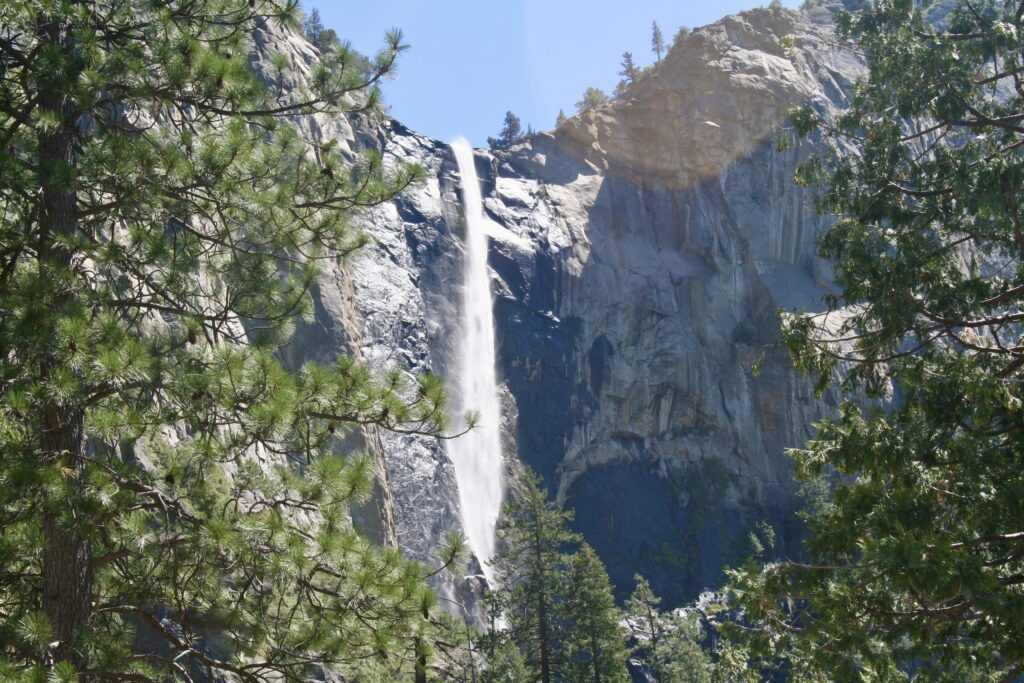We visited Yosemite for the first time in 2006 and stayed in a cabin within the park. We drove from San Jose to Yosemite which is about 167 miles to the east. The park is world famous for its impressive waterfalls, meadows, cliffs, unusual rock formations, walking and biking trails.

Half Dome Rock – It one of the most well-known rocks in Yosemite, perhaps even in the entire United States. It looks like a large rock that has been cut in half – hence the name Half Dome. The hike to the Half Dome hike is 14–16 mile round-trip trek that includes steep inclines, switchbacks, and elevation gain, and the final 400 feet feature cables that span the face.

El Capitan – This is another well known vertical rock formation in Yosemite. The granite monolith is about 3,000 feet (914 m) from base to summit along its tallest face and is a world-famous location for big wall climbing. It is possible to hike to its summit which can take a whole day as it is 16.6 miles round trip with an elevation gain of 4800 feet.

Waterfalls in Yosemite – Most of the water falls in the park are best seen during the months of May/early June as they start to thin out during the summer months.
Yosemite Falls – At 2,425 feet high, it is North America’s highest waterfall, and is actually made up of three distinct cascades that all rush down the north wall of Yosemite Valley. You can see Yosemite Falls from various viewpoints around the valley. You can get the best view by walking the one-mile paved loop trail right up to the bottom of the 320-foot-high Lower Yosemite Fall, from where you can see the Middle Cascades and Upper Yosemite Fall stretching skyward.


Bridalveil Falls – At 620 feet high, it is probably the first waterfall that most Yosemite visitors catch sight of on their way into the valley. Pull off the road at Tunnel View for a great view of the falls with monumental El Capitan to the left and Half Dome in the background. It is best to see this waterfall during springtime. It is an easy half mile walk to the base of the falls.

Ribbon Falls – Ribbon Fall is a delicate waterfall that is only visible on the west side of El Capitan in early spring when all the falls in the Valley are at peak flow. It is most well-known for being the longest single-drop waterfall in North America. The thin stream plummets about 1600 feet down to the valley floor. It is easy to miss seeing it because of the thinness of the stream against the white granite rock. It is located right across the Bridal veil Falls, and you can see it if you walk a few steps back from the parking lot.


Nevada and Vernal Falls – Deep inside the eastern Yosemite Valley, these two famous falls drop elegantly down. You can see them from up high at Glacier Point.
The lower fall, Vernal Fall (317 feet high), drops from a ledge bordered by pine trees down into a tumbling cascade of granite boulders and rocks. The upper fall, Nevada Fall (594 feet high), also shoots over a water slide of granite as it slips down the steep side of the valley.


Yosemite Viewpoints
Tenaya Lake – The panorama of Sierra Nevada peaks from the shores of alpine Tenaya Lake is another classic postcard shot, also off Tioga Road in the park’s high country.

Yosemite sunset from Glacier Point’s amphitheater – Arguably the most spectacular view in the park is at the end of Glacier Point Road, about an hour’s drive from the valley. Here you can gaze out across the Sierra Nevada high country, with the curved tooth of Half Dome prominently in the foreground.
If you walk just a short distance down the Panorama Trail, you might have this epic view, which also includes Vernal and Nevada Falls, almost all to yourself. Note Glacier Point Road is usually closed beyond the Yosemite Ski & Snowboard Area from November until late May or early June.
Tunnel View – At the western entrance to Yosemite Valley, Tunnel View is a must-do stop, no matter which direction you approach the park from. You’ll find it on the east end of Wawona Tunnel along Wawona Road, which is also Hwy. 41. Here you can take photos of the most famous panorama of Yosemite Valley, framed by a forest of pine trees and wide-open skies above. On your right is Bridalveil Fall, plunging off granite cliffs. To the left is the iconic granite rock formation of El Capitan, with Half Dome rising in the background. During peak waterfall season in May, you might spy several more short-lived lacy cascades dropping steeply off the sides of the lushly carpeted valley, too.
Valley View – As you leave Yosemite Valley to see the Mariposa Grove of Giant Sequoias in Wawona near the South Entrance, stop at this roadside lookout along one-way Northside Drive right before you reach Pohono Bridge. You’ll see the Merced River (something missing from the earlier Tunnel View), flanked by El Capitan, which reaches 3,000 feet up to the sky, and opposite it, the imposing Cathedral Rocks and Spires.
Sunset at Olmsted Point – For a whopping dose of scenic beauty, nothing beats a drive along high-altitude Tioga Road to Tioga Pass, about a two-hour drive from the valley. Almost every bend in road brings you another literally breath-taking view. The most famous viewpoint is at Olmsted Point, from where you can peer down into Yosemite Valley and get a unique perspective on iconic Half Dome. You can see the view right from the road’s overlook, or for a more glorious view as shown above, hike the shortest trail in Yosemite (0.2 miles).